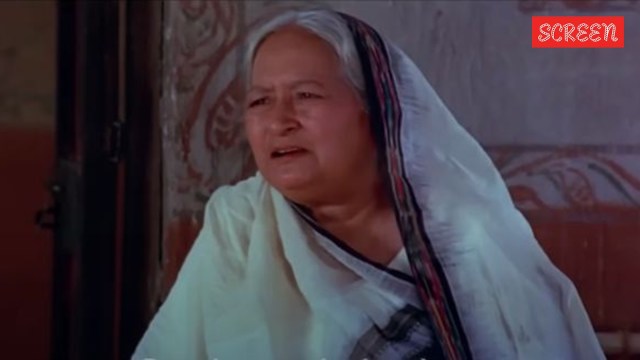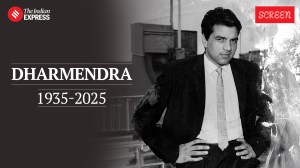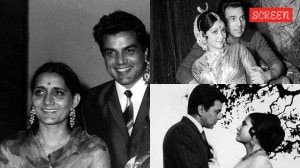Click here to follow Screen Digital on YouTube and stay updated with the latest from the world of cinema.
Married at 12 and mother at 17, Bollywood’s favourite mausi refused to play heroine, insisted on acting even after suffering paralysis
Throughout her storied career, actor Leela Mishra continued playing the role of the maternal figure of the family, and it was typecasting's biggest win till date.
 Leela Mishra as Mausi in Sholay.
Leela Mishra as Mausi in Sholay.Any commercial film has hundreds of people working behind the scenes. Actors and directors are obviously the first ones to bear the fruit of their labour in the case of a Saiyaara or the first ones to be blamed in the case of a Loveyapa (Aamir Khan must have felt that one). The crew too get their due at some point, but there are certain faces that, despite being on the screen, aren’t talked about that often. Some actors play very specific character roles, but the need for such roles keeps changing with the time. For example, the role of the comedic best friend died out by the time the 2000s rolled in, as the lead stars now wanted to dip their hands in all facets of the job, including comedy. But there are certain roles that are seeped so deep within the psyche of the Indian consumer that they can never be abandoned. The caring, mostly helpless, ‘just wants her kids to be married’ maternal figure is probably the best example of this, and Leela Mishra, the actor who played the character of Mausi (aunt) in Sholay, is its best vessel.
Let’s give some background about Mishra herself, and then we will begin dissecting some of her best roles. She was born into a rich family, and her father was a wealthy landowner. She was married at the age of 12. Having received no formal education growing up, she was already a mother to two children by the time she was 17. Interestingly, this marriage, which was undoubtedly a product of what the society thought was status quo back in the day, gave her the chance to join the movie business, as her husband, Ram Prasad Mishra, was an actor. He introduced her to Mama Shinde, who was an employee of the Dadasaheb Phalke’s film company, and Shinde suggested that Mishra should get into acting herself. Slowly but surely, Mishra started her cinematic journey, but according to an old interview, she never wanted to be the ‘heroine’ of any film.
Actor and host Tabassum once recalled on her YouTube channel that she had interviewed Mishra in the 70s, and that’s when the actor told her that she found it very difficult playing the role of leading lady. Tabassum said, “Mishra told me that, ‘Because of the way I have been brought up and due to the values that have been instilled in me, I could never romance a stranger and confess my love for him. These things just don’t sit well with me, and that’s why I decided that I will only do character roles.” Now this revelation completely flips the entire script, because we see so many actors who wish to play bigger and more important roles, but here was Mishra, who refused to be the leading lady because she didn’t feel comfortable. So this then becomes not a story of negligence, but a story of a choice and how that choice affected her career and made her into Bollywood’s most beloved mausi, dadi and nani,.
In the same interview, Mishra admitted that Sholay (1975) changed the game for her. Mishra was part of some of the most iconic scenes of the Ramesh Sippy film, including the much-remembered water-tank scene. But that was Dharmendra’s time to shine, and he played the drunk, in-love, and quite honestly self-combustible Veeru to perfection. Despite all the red flags, Mishra did what Preeti’s father did in Kabir Singh, and she decided to give her blessings to Basanti and Veeru’s union. However, the scene in which she truly shines is when she and Jai (Amitabh Bachchan) are having a conversation about Basanti and Veeru. The two begin a discussion which slowly paints a very grim and problematic picture about Veeru (like it mattered). The entire film is filled with action, drama, songs, and Thakur flaunting his cloak, and this particular scene is the perfect comedic relief. The two actors feed off each other’s energy; that gives birth to a genuine and fathomable conversation. To this date, if you search for the scene on YouTube and read the comments, the people aren’t talking about Big B; it’s just Mishra. Her concerned and inquisitive demeanour goes insanely well with Bachchan’s sarcastic and playful tone, and the two give a masterclass on how to create unforgettable moments without relying on explosions, bombastic BGM or slapstick.
Another great performance by Mishra comes in the Sai Paranjpye film Chashme Buddoor (1981), where she plays Deepti Naval’s grandmother. Apart from the fact that the film remains one of the best ways to transport yourself back to New Delhi of the 80s, it does this with the help of three great actors who play some of the most delinquent characters you will ever see on the screen. The trio of Farooq Shaikh, Rakesh Bedi, and Ravi Baswani play three roommates named Siddharth, Omi, and Jai, respectively. Mishra’s still obsessed with getting the young girl from her household married, and while executing this obsession, she meets the three suitors. Director Sai, who herself is an inspiring woman, talked about Mishra in a recent interview with Filmfare. She said, “She was professionalism personified; I had never met anyone like her. I hope I am not doing her wrong, but she wasn’t educated, but she knew every aspect and nuance of filmmaking. While shooting Chashme Budoor, she improvised the scene where she is climbing up the stairs to get to the house of the boys.”
Mishra discovering the cave of the three men and then stumbling upon an issue of the Playboy magazine is comedic gold. Mind you, she was there to recruit Omi and Jai for a mission to bring her granddaughter and Siddharth together, and the ones who have seen the film must realise that their house didn’t exactly give the best first impression (it did have an Amitabh Bachchan poster though). Sai had also revealed why she thought Mishra was the most professional actor she had ever met and told how the actor persevered through life-threatening conditions just to get the right shot. “I heard a story that when she was doing her very last film, she got a paralytic attack while shooting. Half of her body became paralysed, and the shooting stopped. People got in a frenzy and were making plans to send her back to Mumbai, but she said, ‘No, we still have one shot left.’ She told the crew to shoot her from the side that was still mobile, and she finished that scene.” The director said that Mishra was taken to Mumbai right after that scene, where she passed away.
Mishra’s career was legendary, and her presence was almost ubiquitous. She was prolific and set in her ways, and she became every director’s first choice for when certain roles came around. Her comments on never wanting to be a heroine are quite interesting if you think about it, because in most of the scenes where Mishra got even a modicum of a true chance to showcase herself, she was brilliant. She was the silent, strong type who didn’t want to be in the spotlight, but her art made it clear that if she wanted to, she could. If a person who can’t reach the peak decides to not climb the mountain, that’s not a choice; that’s the limitation of that particular being. But if the one who could climb it backwards and descend faster than air chooses not to, then there is virtue in that choice. Mishra could have gone down as one of the greatest, most loved actors of this industry; she just didn’t want to, she never felt the need for it. For Mishra it was more important to be moral than successful, and while the beliefs that she was defending might have been forgotten now, the thinking behind their protection is commendable, and something we could do with a lot more of.
- 01
- 02
- 03
- 04
- 05


































